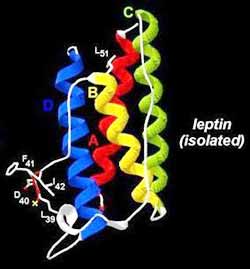Mutant Protein Developed By Hebrew University Scientists

Three-dimensional structure of leptin. The region identified in the picture by numbers as amino acids 39, 40, 41, 42 underwent mutation that converted the normal leptin into an “antagonistic” version.
A unique technique for neutralizing the action of the leptin protein in humans and animals – thereby providing a means for controlling and better understanding of leptin function, including its role in unwanted cell growth — has been developed by researchers at the Hebrew University of Jerusalem.
Leptin was discovered ten years ago and has attracted attention first because of its involvement in control of appetite and later by its effect on growth, puberty, digestion and immunological processes. Leptin can also have negative consequences, such as, for example, enhancing the spread of tumorous growths.
In his laboratory at the Hebrew University’s Faculty of Agricultural Food and Environmental Quality Sciences in Rehovot, Arieh Gertler, the Karl Bach Professor of Agricultural Biochemistry, along with his students, has developed a technique for genetically engineering mutations of the leptin protein. Prof. Gertler has been assisted in this work by graduate students Dana Gonen-Berger and Leonora Niv-Spector.and research assistant Gili Benyehuda.
In experimental work carried out cooperatively with researchers at the Agronomic Research Institute of France and the University of Paris VI, the scientists have developed a model showing which amino acids in leptin are responsible for activating leptin receptors in living cells. By replacing these amino acids with others, they were able to create a leptin variant that could bind with cell receptors, but would be unable to activate them, thereby providing a unique, novel research tool. In this way, the mutated leptin, with the substituted amino acids, acts as an “antagonist,” competing with the normal leptin for the “attention” of the cell receptors to which both leptins are attracted. The result is a “standoff” situation in which the normal leptin is neutralized.
Since leptin is involved in several cell functions, the development of this mutated “antagonistic leptin” could have significant consequences not only for better understanding of leptin action in animals but also on halting undesirable leptin effects in humans, such as undesired cell proliferation in cancer, or in controlling other pathological phenomena in which leptin is a factor.
Thus far, the researchers have succeeded in creating antagonists of human, sheep, rat and mouse leptins.
A company, Protein Laboratories Rehovot (PLR), that was formed by Prof. Gertler and the Hebrew University’s Yissum Research Development Company 18 months ago, was given the license to produce and market the mutated leptin products. Further development is currently being pursued towards testing whether leptin antagonists are capable of anti-cancer activity. This work is being pursued in cooperation with Prof. Nira Ben-Jonathan of the University of Cincinnati in the U.S., with the assistance of Prof. Gertler’s graduate student, Gila Ben Avraham.
Prof. Gertler has presented his work at a symposium of the Israeli Endocrinology Society and most recently at an international biotechnological conference in Miami, Fla., sponsored by the scientific journal Nature.
Media Contact
More Information:
http://www.huji.ac.ilAll latest news from the category: Life Sciences and Chemistry
Articles and reports from the Life Sciences and chemistry area deal with applied and basic research into modern biology, chemistry and human medicine.
Valuable information can be found on a range of life sciences fields including bacteriology, biochemistry, bionics, bioinformatics, biophysics, biotechnology, genetics, geobotany, human biology, marine biology, microbiology, molecular biology, cellular biology, zoology, bioinorganic chemistry, microchemistry and environmental chemistry.
Newest articles

Properties of new materials for microchips
… can now be measured well. Reseachers of Delft University of Technology demonstrated measuring performance properties of ultrathin silicon membranes. Making ever smaller and more powerful chips requires new ultrathin…

Floating solar’s potential
… to support sustainable development by addressing climate, water, and energy goals holistically. A new study published this week in Nature Energy raises the potential for floating solar photovoltaics (FPV)…

Skyrmions move at record speeds
… a step towards the computing of the future. An international research team led by scientists from the CNRS1 has discovered that the magnetic nanobubbles2 known as skyrmions can be…





















